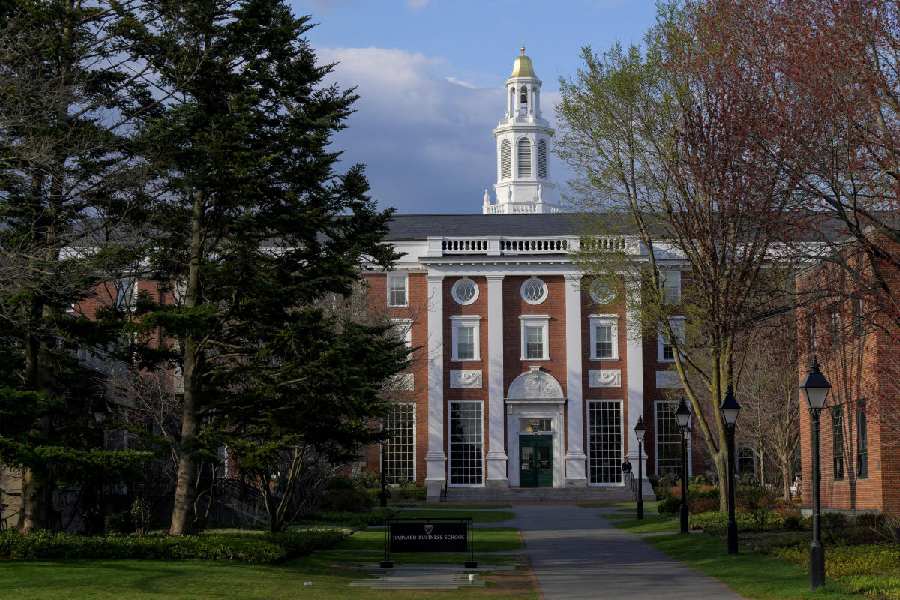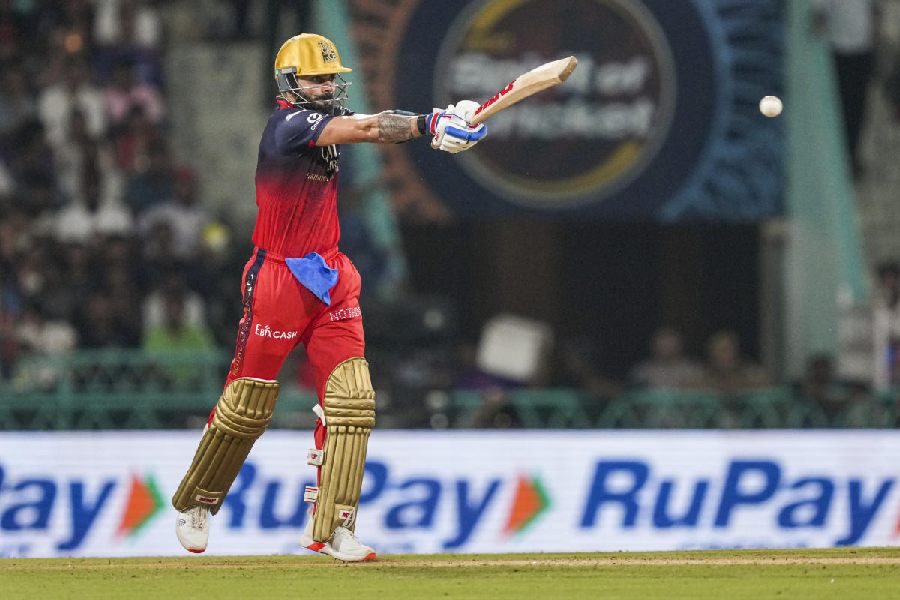
THE CAULIFLOWER By Nicola Barker, William Heinemann, £16.99
Although Nicola Barker's narrative begins with Sri Ramakrishna's childhood, the reader should not conclude that it continues in a linear fashion, as most conventional biographies do. There are digressions, sound-effects, film takes interspersed with haikus. It is a shuffling of the cards, a re-arrangement of the pieces. What is charming, captivating about this book is that Barker sees the drama of Sri Ramakrishna's story. She presents it as scenes in a script of a film, and even simulates the sound of the clapperboard that syncs the takes.
The story of Sri Ramakrishna might easily be said to begin with a pinch of salt. This is the thread. Yes, salt is the thread of Barker's biographical novel. Why salt? Many of the most important occasions of history concerned salt. These are enumerated: ancient Hebrews made a covenant of Salt with their jealous God; Christopher Columbus's voyage was financed by Spanish salt production; salt riots played a central role in the American Revolution; Mahatma Gandhi led 100,000 protesters to the 240-mile Salt Satyagraha and the author somehow excavated the fact that Rani Rashmoni's father-in-law started his career as a clerk in a Calcutta salt distributing agency. And therefore, she concludes, the story of Sri Ramakrishna started with salt.
The book, Cauliflower, is made flavourfully digestible with salt. Why salt? Perhaps because Sri Ramakrishna is depicted as the salt of the earth. And why cauliflower? Why cauliflower, of all mundane objects? A small incident towards the end of the biographical account explains. Barker says: "I shall not waste your precious time by extemporising about his golden skin and his heavenly trances (all of which you are familiar with to the point of tedium), but I must tell you about the reception of that most fateful of vegetables, the cauliflower."
When Sri Ramakrishna, sitting in his room in Dakshineswar, is presented a cauliflower by a devotee, he expresses his pleasure but is suddenly seized with anxiety. He exclaims: '"We must hide it! Quickly! Quickly! Before my nephew, Harryday, comes."' But it was too late! Hriday strides into the room at that very moment. Sri Ramakrishna tries to hide the cauliflower behind his back but Hriday leaps forward to seize it, saying: "'You know that you cannot digest it, Uncle..."' Typically, Hriday tries to protect Sri Ramakrishna.
The theme develops around this relationship, with Hriday always trying to protect Sri Ramakrishna and Sri Ramakrishna's unworldliness, which is a constant headache for Hriday, and makes the story fun and even slapstick. It is bound to make the reader chuckle, giggle, click his tongue and roll up his eyes. The whole drama is projected from the point of view of Sri Ramakrishna's nephew, Hriday. Hriday's part is played by the author herself. Why? Because without his wealth of biographical knowledge, Sri Ramakrishna's life could never have been written. Hriday was the only living person to have stayed with the Master throughout his 12-year-long sadhana.
Hriday says way back at the beginning: "This is our story, because Uncle belongs to us. And it is colourful. And sometimes I don't quite understand where the joyous kirtans and ecstatic love poems of Ramprasad and Chaitanya - or the heroic stories of The Mahabharata and the Puranas - begin and the tales and mysteries of Uncle's life end. Everything is woven together in my mind... I too am a part of it all, and if I try to dismantle it, thread by thread, I will lose myself... and although Uncle depends on me for everything, my hold on Uncle has never been a strong one. Uncle has an independent spirit. Uncle is single-minded but he is also simple and humble as a child."
"Uncle can bring such joy to people. He is full of love... But there is a perversity in Uncle. And this is his longing for God, which is almost like a sickness. It is very nearly a madness." Barker's book has caught the one thing that characterizes Sri Ramakrishna: his bhava... She writes: "Uncle had a very focused mind. All Uncle's attention would be drawn to one point or idea or image and then he would become completely lost in its contemplation. Anything - even most curious things - might bring about this devotional state."
"One could light a room with Uncle's smile. One could melt ice with it. Uncle's smile could warm any soul and bring comfort to it. To be the recipient of one of Uncle's tender smiles is to feel like the richest man on earth... Oh, how I hunger and thirst for that smile of Uncle's! But presently I am most cruelly deprived of it, because Uncle has returned to Kamarpukur to stay for some months with his beloved mother... I pine for him terribly. In the way that Uncle pines for Ma Kali..."
There is the bit about Pagli at Cossipore during Sri Ramakrishna's last illness: "In the garden, a woman suffering from acute mental illness (the disciples call her 'Pagli') is crying and entreating whomsoever may listen to be granted access to the bedside of the dying guru. Pagli has chosen to worship Sri Ramakrishna... in the spiritual attitude of the lover, and so she torments him, at every opportunity, with her passionate, crazy and utterly inappropriate displays of affection.
'The disciples are sick of Pagli. She is prone to breaking into the house and forcing her way into Sri Ramakrishna's room to demonstrate her deranged love for him. She tortures him from her post in the garden with her hysterical screaming and her perpetual commotion. Recently, over-tired and exasperated, a couple of the disciples went so far as to beat her up. But still she returns, battered and bruised. Still she chides and wheedles and yells.
'The guru (who will not be called guru) is quiet and uncomplaining. He receives visitors, even though speaking often causes his throat to haemorrhage. He has been banned from talking - he talks only of God...
'Of course Sri Ramakrishna has no control over his spiritual moods. If he is inspired by thoughts of God, if he hears religious singing, if he talks of the Mother, if he smells a particular flower used in worship, or a whiff of incense or of camphor, he will enter a state of ecstasy. He cannot help it.
'His faith is killing him...
'On that long, hot night of 16 April 1886, Girish - with his artist's soul - pleads Pagli's case before her many detractors. Did he not pester and insult the guru himself, for years, he demands, before he finally relented and saw the light? And now that he has finally seen it, how is it possible for him to resent the warped, emotional whirlwind of Pagli for enthusiastically embracing that exact same impulse?
'The other disciples aren't receptive to Girish's kindly analysis (they could happily kill her for the trouble she's caused), but Girish still persists. He walks over to the window and peers out. There Pagli stands, in the garden, bathed in silver moonlight, her dark hair awry, her arms covered in bruises. She is calling the guru's name as if her heart would break. 'Pagli is truly blessed,' he murmurs, turning towards the emaciated guru, his soulful eyes filling with tears, 'to love you this much. If she calls on your name with such faith and devotion, surely no real harm may befall her?'
'The tormented guru will not speak. He just closes his eyes and smiles."
Back to the thread: salt is the thread that ties the story together. At the end of her biographical novel of Sri Ramakrishna, Barker makes a pun on nun, the Bengali word for salt, to bring in another subject: the nun, Mother Teresa. She writes : "[There] will come another saint (gasp!), hot on his heels, to this lost and chaotic and sprawling metropolis...
'She will be unconventional, too... She will not embrace modernity, per se, only the dignity of work, of rolling up one's sleeves and mucking in, of good, honest sweat and heartfelt sacrifice.
'Like Sri Ramakrishna she will eschew aversion... Which is fortunate. Because she is here, right here, in the heart of the slums of this belching, rotting, teeming city. She will love the unloved, the unlovable. This is her mantra...
'[T]his other saint... will establish a Home for the Dying a stone's throw from Kalighat, the most famous and ancient of all the Kali temples..."
After depicting the related conversations and narratives, Barker returns to the cauliflower incident: "[F]or reasons of authenticity - that all the most important details of this curious little anecdote are absolutely true - the argument, the cauliflower etc. - but for some perverse reason (known only to herself) the author of The Cauliflower (can we even truly call her 'the author'? The collagist...? The vampire...? The coloniser...? The architect...? The plagiariser...? The skid-mark...?) has chosen to fictionalise this account." Although she has narrated the entire story of Sri Ramakrishna and those who lived with him as fiction it is mostly true and made flavourful by a very contemporary ambience.
Barker herself describes her biographic novel as a "painstakingly constructed, slightly mischievous and occasionally provocative/chaotic mosaic of many other people's thoughts, memories and experiences." She admits that she is not a practising Hindu, nor ever visited Calcutta. Although English and born in South Africa, she had been fascinated, even obsessed by Sri Ramakrishna for much of her life. Her book is written with a tenderness and sensitivity - an affectionate presentation of Sri Ramakrishna's bhava, of his extraordinary, incomparable yearning for God, the charm and playfulness and drama of his personality that make this book an eye-opening feat of contemporary hagiography. In these days of cringing from fear and violence, this entertaining book about Sri Ramakrishna, who embraced the gamut of Hinduism, Islam and Christianity, is a remedy that will free the stick-in-the-mud devotee from stagnation and introduce Sri Ramakrishna to a wider public, by a bit of cauliflower made flavourfully digestible with salt.










